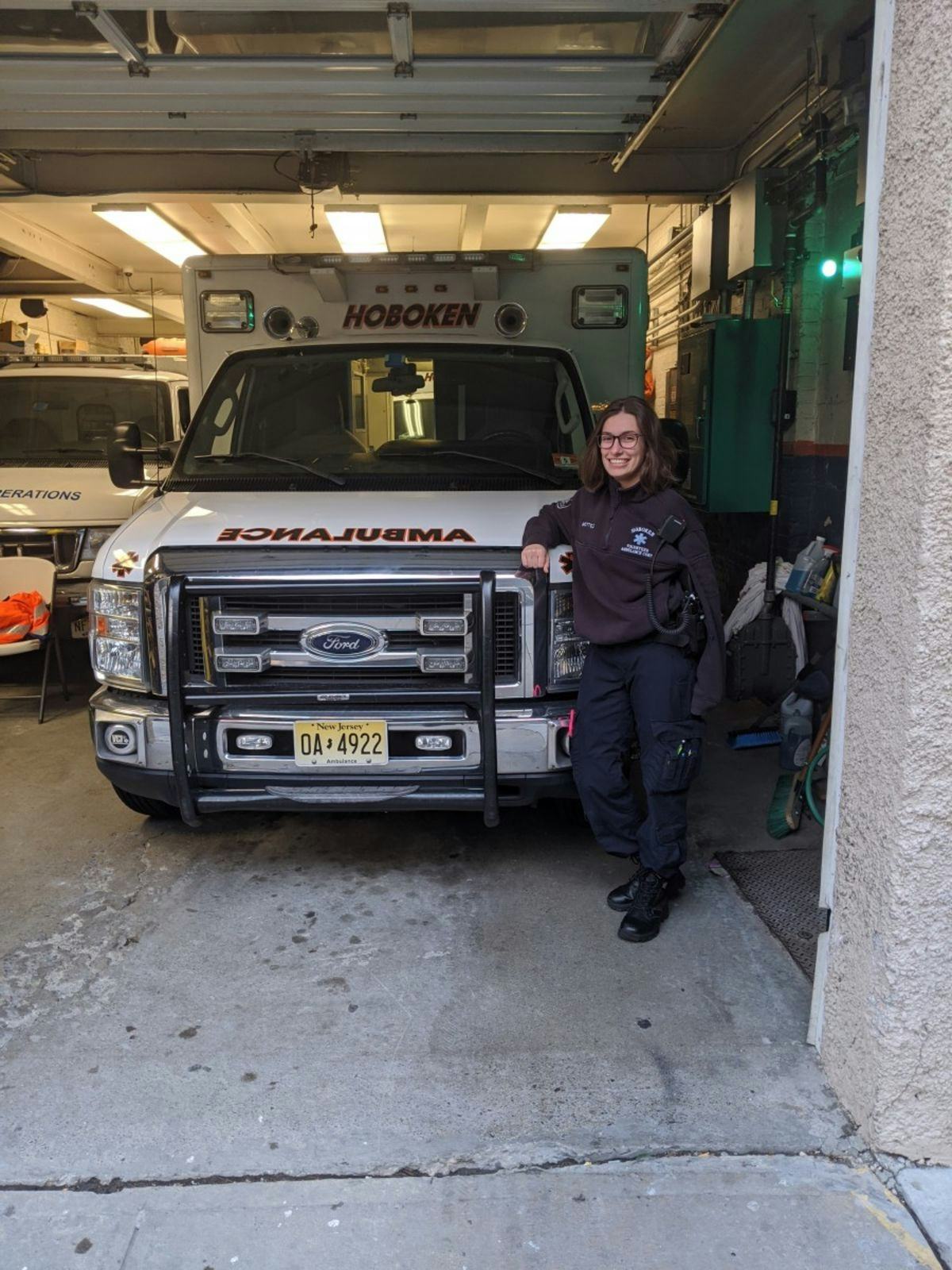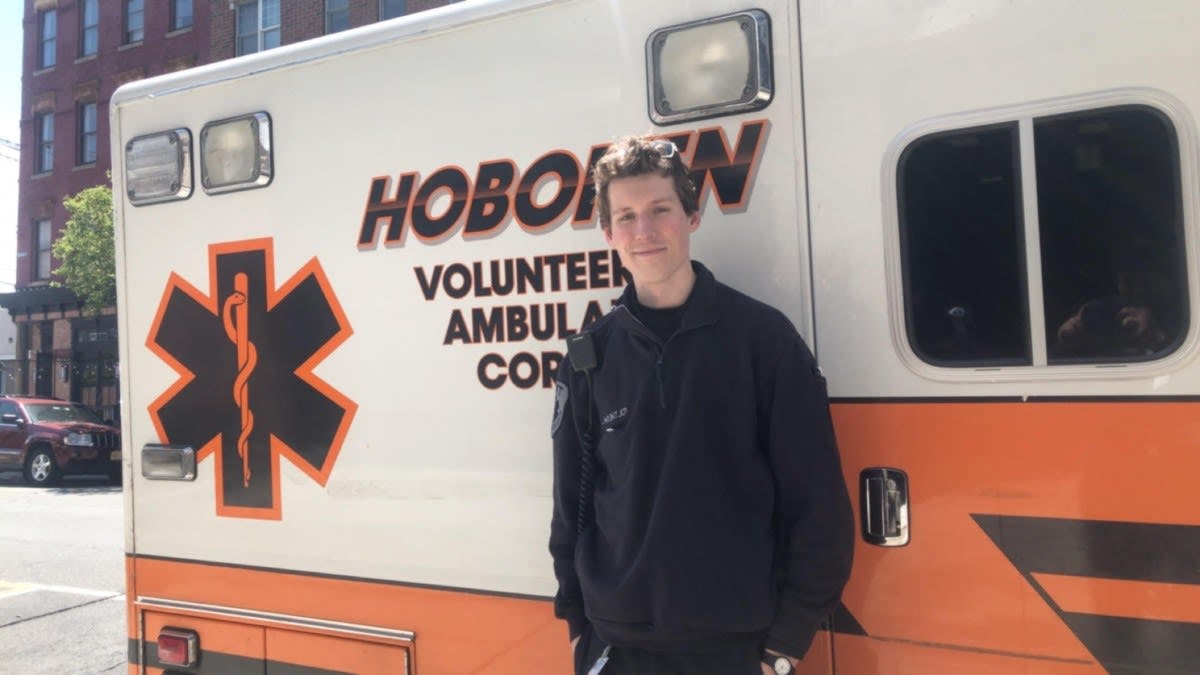Undergrad Students Volunteer for Emergency Services During COVID-19 Pandemic
While the crisis tests students’ commitment to community outreach, they rise to the challenge
When students begin their journey in the School of Engineering and Science at Stevens Institute of Technology, they are often motivated by the institution’s mission of contributing to the solution of the most challenging problems of our time. One group of students had no way of anticipating that their commitment to serving their community would be challenged in the greatest way possible in the form of the COVID-19 global pandemic.
Stevens students genuinely want to serve both their personal communities and humanity on a global scale, and many of them volunteer in community outreach programs, particularly those that relate to their future career paths. One such opportunity is with the Hoboken Volunteer Ambulance Corps (HVAC), the primary emergency care and transport provider in Hoboken.
“I thought it would be a great way to see firsthand what it’s like to be a healthcare provider,” said Michelle Gnidash, a biology undergraduate. “When I found out HVAC does not bill a single patient and runs fully off volunteers and donations, I knew I needed to do my part.”
“Working in an emergency environment during such an unpredictable time has shown me the best of medicine,” Gnidash said. “The initial fear of a COVID-19 call is undeniable, but as soon I see my patients’ faces, my only focus is keeping everyone safe and administering proper care. Despite these challenges, the experience has only strengthened my love for medicine.”
Procedural changes and increased personal protective equipment
Biomedical engineering major Nicole Mottole notes that much of the day-to-day emergency work is unchanged. “You treat immediate life threats for the patient and transport them safely in order to get them to a higher medical authority,” she said. “The real difference is that we have to enter scenes with high indexes of suspicion and always take precautions.”
“Our call volume raised through the roof, and we are needed more than ever to keep the ambulances running for the community,” said Jason Buckman, a science technology & society undergraduate. “We have to be far more careful.”
Joshua Ross, who graduated in 2018 with a degree in chemical biology and is currently a medical student at the New York University School of Medicine, described the added workplace stress of cumbersome protective gear.
“We are wearing full-body Tyvek suits, N95 masks, goggles, and a face shield,” he said. “It is significantly harder to move around, talk to patients, and perform physical exams while fully gowned, and that is not even mentioning how hot it is or how difficult it is to breathe under everything.”
Additionally, emergency responders have had to make increasingly difficult decisions due to the strain the virus has placed on resources.
“Paramedics have been limiting on-scene intubations because when you bring an intubated patient into the emergency room, they need to be hooked up to a ventilator, and a lot of resources go to that patient,” Nicole Badalyan, a biomedical engineering undergraduate, said.
“The flow of calls has changed,” Gnidash added. “Previously, I could be taking vitals while my partner charts and obtains past medical history. Now, we have to strategize and limit the amount of people who come in contact with patients.”
The impact of the pandemic isn’t limited to actual virus-related calls. There are new considerations to be made, particularly with patients who could be seriously affected by potential virus exposure.
“Medical emergencies still happen. Just because there is a pandemic going on doesn't mean that people stop having heart attacks, strokes, drug overdoses, et cetera,” Badalyan said. “When you have an immuno-compromised or high-risk patient and you have to take them to a hospital that is full of a contagious virus, it's quite scary.”
While the protective equipment is ultimately for the good of both providers and patients, it still presents unique challenges. “It's difficult to give patients the same care when you're physically compromised or restricted,” Badalyan said. “And it's scary for the patient because they can't see their provider.”
Increased patient anxiety and evolving interactions with patients
Naturally, increased patient anxiety is another hurdle many emergency responders encounter during the pandemic.
“I have come across a lot of scared patients,” Gnidash said. “To minimize exposure, patients are encouraged to not have anyone accompany them to the hospital. This increases the fear and anxiety that many patients have. I have to ensure that I am extra supportive to my patients during such an uncertain time.”
Effective communication is challenging during this time when compassionate care is even more important than ever. “[The personal protective equipment] genuinely places a barrier between us and our patients, which we know is for everyone’s safety, but diminishes the amount of support, be it medical (from our assessment) or emotional, that we can provide to our patients,” said Ross.
Gnidash also expressed that due to these constraints, clear communication is more essential now than ever.
“With full protective gear, patients are unable to see my face. Knowing that body language is a significant form of communication, I have paid extra attention to my words,” she said. “I have carefully strategized how to best communicate while wearing Tyvek suits, goggles, facemasks and other PPE that make the whole experience less personal.”
Mental health considerations
The psychological impact of providing emergency care during a pandemic can take a toll.
“It’s scary interacting with confirmed COVID-19 positive patients, even when wearing the proper PPE,” Buckman said.
Badalyan expressed fear of unknowingly spreading the virus because contamination is always a possibility.
“It’s scary to come back from a shift and think maybe I missed wiping something down,” she said. “Did I touch my face? When you get a call for a COVID-19 patient, you don't think twice. It all comes when you begin decontaminating the ambulance and taking off the Tyvek suit.”
“I’ve seen three deaths in my six months at the Corps and I’ve seen many others who have lost their willingness to live,” said Kyriakos Chatzis, a biology major and pre-med student. “It really makes you put your own life in perspective.”
Emergency responders are vital during normal times, and have found themselves to suddenly be on the “front lines” of a pandemic they could have never known to prepare for emotionally. They provide their communities selfless service daily, and it can be easy to put their own self-care on the backburner.
“You can find that you’re capable of achieving a lot; just make sure that you’re also leaving time for yourself,” Mottole said. “Mental health should always be a priority.”
Hoboken community support
The student volunteers expressed how encouraging it has been to see the way the Hoboken community has shown support for their emergency responders. “The fact that there are people out there who are consciously making the effort to go to their windows and cheer every night at 7 p.m. has been really heartwarming and makes me realize how appreciative people are,” Badalyan said.
Of this nightly cheering, Gnidash added, “It’s a great way to boost morale and feel the support of the community. Hoboken residents and organizations have also been donating delicious meals to the ambulance corps. Having gourmet dinners between patients is always a bonus!”
“Not all residents of Hoboken know that we are 100 percent volunteer, meaning that none of our members get paid for our work, nor does anyone get billed if they are seen by us,” Ross said. “Whether it is the food that local families or businesses drop off, shout-outs from the mayor, or the 7 p.m. applause for essential workers, people are beginning to see some of the work that we do in the community.”
“You normally don’t see the appreciation by the community, so it’s nice to know that we are making a difference,” Kyriakos said.
“I hope that there’s continued support from the community even after this crisis subsides,” Buckman said.
Career impacts, and considerations for the future
For many of the student volunteers, the pandemic has provided eye-opening experiences.
“The first thing that this has taught me is how interconnected the medical field is. I guess I had always imagined the medical field as being in its own little bubble,” Ross said.
“Whether it be the truck drivers and pilots who are working overtime to deliver critical supplies to medical facilities,” he continued, “the hospital cleaning staff who are working around the clock to sanitize the entire hospital and patient rooms to ensure everyone is safe, our construction workers who are constantly working to add capacity to hospitals around the U.S., and the engineers who are helping to upgrade pipes and wiring to convert regular rooms to ICU rooms and make the room negative pressure rooms to keep airborne virus particles inside the room.
"There is so much that goes on behind the scene in the medical field that we sometimes take for granted, but it truly is amazing to see all of these different people come together behind a common goal in this time of crisis.”
The experience, though challenging, has deepened student commitment to their chosen career paths, and in some cases even has some students considering a career shift.
“I've always thought I wanted to be an orthopedic surgeon, but now I've also begun to consider epidemiology, emergency medicine, et cetera,” said Badalyan.
Student volunteers are ever looking forward to the future, inspiring them to seek solutions to the problems that have presented themselves during this global crisis.
“It’s inspired me to look into ways to make medical supplies more reusable while maintaining the same standard for sanitization,” said Salvatore DiMaggio, a pre-med student in biomedical engineering. “In the future, there will hopefully be more sustainable and more plentiful supplies for all possible scenarios.”
Computer science undergraduate Lachlan Mountjoy added, “I hope that this pandemic shows people that investments in public health and prevention measures are critical for protecting everyone.”



